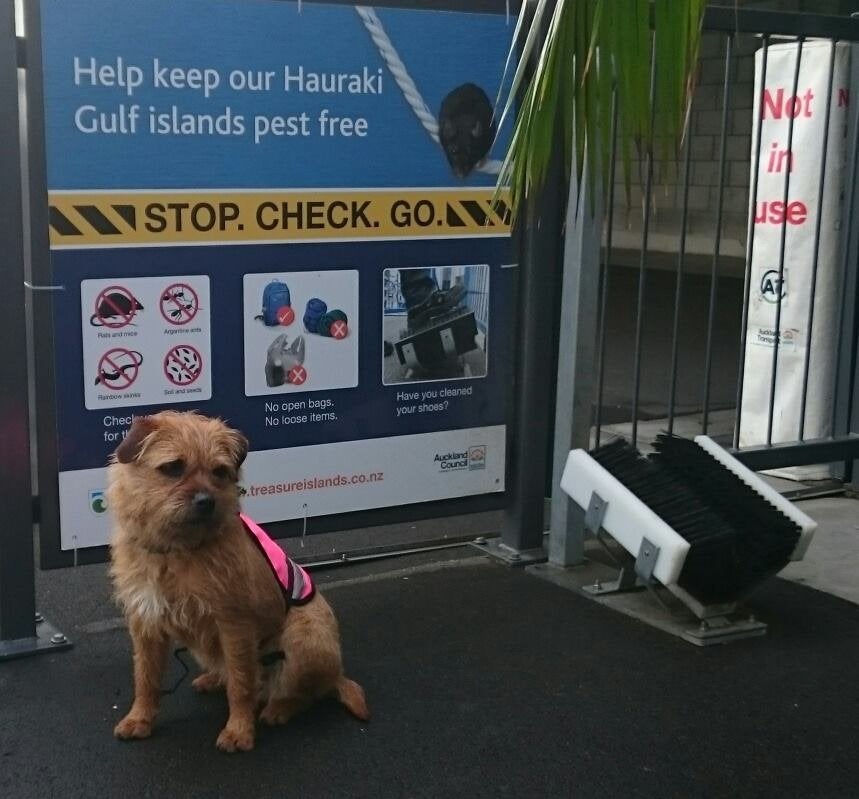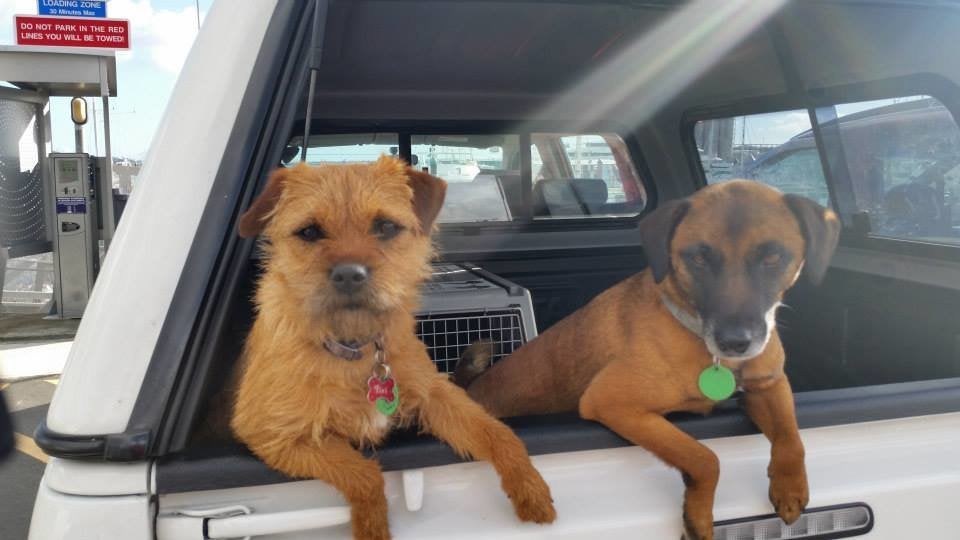Visit the docks in Auckland, New Zealand, on any day of the week and you might just see Piri puttering around, clad in a smart orange vest and going about her work with the utmost professionalism. Observe as she wanders to some bags and does a thorough search, before clambering aboard a barge to take a good sniff around.
Piri works for the New Zealand government in the Department of Conservation.
She also happens to be a dog.

Piri is a ratter, a specially trained dog who can sniff out rodents. Her job is to find rats and mice that might be hiding in luggage or in crevices aboard ships that are heading for islands around Auckland. These islands are home to some of New Zealand’s most threatened and beloved native species, like the country’s national animal, the very stout and very cute kiwi, and the world’s only nocturnal flightless parrot, the kakapo.
One of New Zealand’s greatest conservation accomplishments, these so-called “island sanctuaries” are entirely pest- and predator-free, allowing these endangered animals to thrive without threat.
There are currently around 100 of these pest-free islands in New Zealand. Conservation dogs like Piri play a central role in keeping them safe.
“Conservation in New Zealand is often about removing predators that are killing our native wildlife,” Fin Buchanan, technical advisor with the Department of Conservation, told The Huffington Post over Skype from his Auckland office last week. “Before humans, native species evolved in New Zealand in the absence of mammalian predators. But when the Māori first arrived [from Polynesia in the 1200s], they brought animals like the omnivorous Pacific rat. Then a few centuries later, the Europeans came and brought a whole host of other mammals.”
In the face of these new threats, New Zealand’s native species ― many of them, like most of New Zealand’s birds, are endemic, or found nowhere else on Earth ― had “no way to defend themselves,” said Buchanan. Many endemic creatures, including the laughing owl and the narrow-bodied skink, soon went extinct, killed off by these introduced predators.
Today, several endemic species are considered threatened in the wild. According to Dr. Bruce Robertson, a conservation biology professor at New Zealand’s University of Otago, mammalian predators continue to be “one of the greatest threats” facing the country’s native wildlife.
“It’s an ongoing problem,” he told HuffPost over the phone Thursday, “and it’s impacting areas across the country.”

Conservation Dogs, A Brief History
New Zealand isn’t the only place in the world where dogs are being used in conservation work. In Spain, for example, dogs are being deployed to find poisons to protect endangered wildlife, and the Montana-based Working Dogs for Conservation trains dogs to “protect wildlife and wild places.” But the oceanic country is believed to be the first to use dogs in this way.
According to Buchanan, the history of conservation dogs in New Zealand stretches back to the 1890s, when a conservation-minded citizen named Richard Henry used dogs to find kiwi and kakapo, and then put these threatened birds on what he thought was a pest-free island.
“Sad to say, the island he chose was within swimming distance of stoats [a kind of weasel] and these birds were killed,” Buchanan said.
Henry is said to have died lonely and disappointed, his island experiment an apparent failure. But today, Henry is remembered as New Zealand’s “first conservation hero,” his methods the cornerstones of the country’s conservation work.
Not only have pest-free islands come to play a central role in the protection of native species, but New Zealand has become a “world leader in island pest eradication,” Buchanan said.
“Without these island sanctuaries,” Robertson noted, “so many of our endangered species still living today would be gone.”
Since the early 1950s, the New Zealand government has been using dogs to help in the creation and maintenance of these pest-free islands ― but for decades, the canines were deployed on an ad hoc basis.
It wasn’t till 1998, when the Department of Conservation established the conservation dogs program, that dogs started to be used more consistently for this purpose. Today, the initiative has more than 60 dogs, Buchanan said.
Some of these dogs are used, like in Piri’s case, to find predators like rodents, cats, ferrets, stoats and even the Argentine ant, an omnivorous, invasive insect. These pest-detection dogs, which are usually terriers (bred for centuries to find and hunt small animals), can either help sniff out predators on the offshore islands themselves or can thoroughly check ships that are sailing out to the islands.
Pai, Piri’s half-brother, is a pest-detection dog. Like his sister, the 7-year-old terrier mix is also trained to find rodents:
There’s also Milo, a conservation dog trained to find wild cats:
Conservation dogs are also employed, as Henry used them, to find threatened species like the kiwi or the whio, a type of endemic duck. These animals can then either be transported to island sanctuaries, or heightened predator management can be undertaken directly at their habitats.
Species-detection dogs, as they’re so called, “can also help us monitor whether or not pest control is working in a certain area,” Buchanan said. Dogs traditionally bred for bird hunting, like Labradors, German shorthaired pointers and Irish setters, are typically used for this task.
Neo is a dog trained to find whio and other threatened birds. He’s a German shorthaired pointer:
Here’s him hard at work:
Here’s Rein, another bird-detection dog, successfully finding a kiwi:
And here, Rein poses with a friend:
A Nosy Business
Dogs have played an extraordinarily important role in New Zealand’s conservation efforts, Robertson said.
“They’ve been a really valuable asset. They can find almost any animal really quickly. They save time and money, not to mention species,” he said.
Robertson added that dogs are “really the best tool” to find some of New Zealand’s most threatened wildlife. The most efficient way to find the “cryptic” and skittish kakapo, for instance, is to use a dog, he said.
“It’s all thanks to that black thing at the end of their faces,” Buchanan explained when asked about a dog’s keen detection abilities. “We’re learning more and more about just how powerful dogs’ noses are. Dogs can detect whether a person has cancer by sniffing urine samples, or whether a person is about to have an epileptic fit.”
“When it comes to pest eradication, we’re often looking for the cleverest animals ― the ones that are good at avoiding traps,” he added. “For threatened species, some of them, like the whio, are extremely shy and hard to find. That’s when [a conservation] dog is most effective. It can pick up those scents.”
Buchanan is himself a conservation dogs veteran, with a career spanning more than 40 years in the field. He also happens to be the owner of both Piri and Pai. His longtime partner, Carol Nanning, is the handler for both dogs; Buchanan is currently the head trainer for all pest detection dogs and their handlers in the program.

Buchanan proudly recalled several instances over the years when his dogs triumphed on the job.
In 2008, a rat was discovered on an otherwise pest-free island in the Hauraki Gulf near Auckland, but the wily rodent proved impossible to trap. So Buchanan brought one of his dogs to the island to search for the animal.
In under two hours, he said, the rat had been found and killed.
On another, more recent occasion, one of Buchanan’s dogs found a rat hiding deep in the engine compartment of a van headed to a pest-free island. There was “no way that we would’ve known there was a problem if it wasn’t for the dog,” Buchanan said.
Rats are responsible for the extinction of more native animals than any other predator in New Zealand, according to Buchanan. There is, for instance, the ship rat, which is an excellent climber and poses a serious threat to native birds; and the Norway rat, which he says is “taking out a whole host of native insects and lizards and shore birds.”

‘We Created The Problem’
The continued survival of New Zealand’s native species is ultimately not just “important for New Zealand, but for the whole world,” Buchanan said.
“Birds like kiwi only exist here and nowhere else,” he said. “We New Zealanders owe it to the world to conserve these animals that only live here. These animals are only threatened because humans caused the problem in the first place. We created the problem, so we need to deal with the problem.”
Saving these animals will require a “multi-pronged approach,” Robertson said. “The best conservation method to use depends very much on the species.” But dogs, he noted, will continue to be a critical tool in this fight.
Buchanan said there are promising signs that the conservation dogs initiative may be fortified in the coming months.
“We have about 60 dogs currently in the program, but we have struggled. This last summer and autumn, 12 islands had pests reinvade. Had we had better surveillance, we would’ve dramatically reduced those pest incursions,” he said.
Last year, a group of stoats decimated a population of saddlebacks, a kind of endangered wattlebird, after the predators managed to sneak into an ecosanctuary near the city of Dunedin.
“People looked and looked and looked for these stoats, but they couldn’t find them,” Robertson recalled. “Finally, a dog went to the sanctuary and it almost immediately found a nest of stoats. If they could’ve got a dog in there sooner, perhaps they could’ve prevented this sad outcome.”
There are plans to set up a standalone conservation dogs unit later this year, with more dogs and better funding.
“With more resources, we’ll be able to reduce pest incursions,” Buchanan said. “There will also be more capacity to train handlers and dogs, and to strengthen the program as a whole.”
The dogs can also be used for advocacy, he added, “to help remind people of their individual responsibility to check their gear and boats before they go out to islands.”
“These dogs, marching around in their vests, very businesslike and all, really capture people’s hearts,” he said. “They’re the perfect conversation starter.”
Find out more about New Zealand’s conservation dogs program here and explore Motutapu Island in the Hauraki Gulf, one of the country’s many pest-free islands, in the video below: